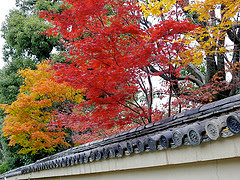



 Koto-in Zen Temple (1601) established at the behest of military leader Hosokawa Tadaoki (1563-1645), is a sub-temple of Daitokuji located within the precincts of the main temple. The famous tea-house known as Shoko-ken that stands at this temple was built by Hosokawa and adjacent tea-house, known as Horai. Koto-in has numerous rare paintings and art objects, both Chinese and Japanese, many now classified as National Treasures and Important Cultural Properties. The garden of this temple is a masterpiece of elegant simplicity, famed for the beauty of its maples during the autumn season - perfect!
Koto-in Zen Temple (1601) established at the behest of military leader Hosokawa Tadaoki (1563-1645), is a sub-temple of Daitokuji located within the precincts of the main temple. The famous tea-house known as Shoko-ken that stands at this temple was built by Hosokawa and adjacent tea-house, known as Horai. Koto-in has numerous rare paintings and art objects, both Chinese and Japanese, many now classified as National Treasures and Important Cultural Properties. The garden of this temple is a masterpiece of elegant simplicity, famed for the beauty of its maples during the autumn season - perfect!







Hoshun-in Temple Donkokaku (1617) - bridge, pond and rokaku (several storied structure). Though not very large, its elegantly landscaped garden, with oddly overlaying rocks, is attractive for its three-dimensional composition and offers outstanding seasonal beauty in the flowering season due to lilies and irises surrounding the pond and Kagantei Zen rock garden.










